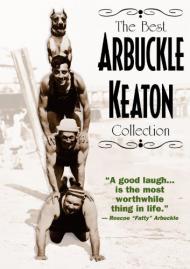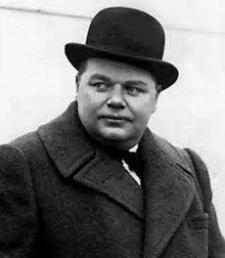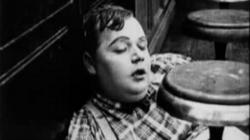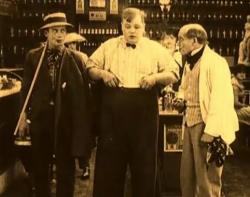Movie Review
His Wedding Night

US Release Date: 08-20-1917
Directed by: Roscoe (Fatty) Arbuckle
Starring▸▾
- Roscoe (Fatty) Arbuckle, as
- Drugstore soda clerk
- Al St. John, as
- Rival Suitor
- Buster Keaton, as
- Delivery Boy
- Alice Mann as
- Alice
![1.75 star[s] out of 4](http://www.threemoviebuffs.com/static/images/global/featured_gold_stars.png)
![1.5 star[s] out of 4](http://www.threemoviebuffs.com/static/images/global/featured_gold_stars.png)

Roscoe Fatty Arbuckle
Despite the provocative title, His Wedding Night has nothing to actually do with a groom's wedding night. In fact, this film finds Arbuckle, Keaton and St. John in very, very familiar territory. I wonder if the audiences in those days ever got tired of the same plots being retreaded all of the time.
In His Wedding Night, Arbuckle again is working at a store and fighting for the affections of a girl. This time he works at a drug store humourously called Koff and Kramp Druggist. His girlfriend accepts his proposal of marriage but St. John will not be deterred.
Keaton plays the delivery boy who brings the wedding dress. As he enters the drug store he has a tick in his eye that Arbuckle assumes means that he wants something hard to drink. Arbuckle pours him a beer and Keaton gets drunk. He then takes the dress upstairs for the bride-to-be, who insists that Keaton put it on so she can admire it. St. John kidnaps Keaton thinking he is the girl. Arbuckle pursues and they fight and frantically fuss for awhile.
The tired plot left little to really enjoy. I can always tell when an old film is boring me when I find myself more fascinated by the historicalness of the film than the entertainment of it. Here you can see that people paid 26 cents for gas. Not a gallon, but for a fill up. They didn't even keep track of how much was used. As a joke, Arbuckle changes the 26 cent sign to $1.00 when a fancy car pulls up.

Fatty Arbuckle sleeps on the job in His Wedding Night.
I’ve made the comparison before between two-reel comedies and television sitcoms. In pacing and style these movies were the precursor to television’s most enduring entertainment format. Silent two-reelers were the true birth of this art form. Audiences knew exactly what they were paying admission for. They got to see familiar faces acting silly with no consequences and a guaranteed happy ending in twenty minutes.
In 1917, as the First World War raged in Europe, Fatty Arbuckle was second only to Charles Chaplin as the most popular comic in the movies. As Eric said His Wedding Night sticks to a tried and true formula. Arbuckle often worked with food and somehow always got the girl at the end. Al St. John and a pre-stardom Buster Keaton were almost always on hand in supporting roles.
St. John’s best scene is where he proposes to the girl and is rejected and told she is already engaged to Arbuckle. He goes a bit nuts, first bursting into tears like Stan Laurel would later do and then by attacking the girl and even trying to bite her face. It is quite outrageous and funny. It never ceases to amaze me how this very talented comic never became a star on his own. He simply lacks that indescribable something that comes across on the screen. Either you have it or you don’t and St. John, for all his talent, did not.
As usual Keaton makes his entrance last and always in an amusing and memorable fashion. Here he rides up on a bicycle and does a signature pratfall off of it. The winking bit between him and Arbuckle is amusing. The sight of Keaton in a dress was always good for a chuckle or two. The long bridal veil and his posing really sell it. “Her” abduction from the second floor window demonstrates what silent comedies did best, namely daring action.
Then as now, stereotypes were commonly perpetuated for a laugh. A large black woman and an effeminate man are both made the butt of gags here. At least in those pre-PC days people were free to laugh at whatever they found amusing and weren’t persecuted by the hypocrisy of today’s thought police. I’m sorry (not really) but if something is funny then it's funny. We all need to lighten up and laugh more which is what these early silent comedies were all about.
Although His Wedding Night is not a particularly inspired production it is better than Eric would have you believe. It provides twenty minutes of pure (lowbrow) escapist fun.

Fatty Arbuckle in His Wedding Night
I can't believe neither of you mentioned the date rape scene! Okay, so it's only kisses Fatty steals, but still, he does it by putting a girl to sleep with chloroform and then kissing her several times. Like the joke involving the black woman putting charcoal on her face as makeup, it's a joke that would never fly in a movie today. Although, like you Patrick, I agree that no topic should be above humor.
Apart from that one shocking moment however, I have to side with Eric on this one. It's fairly run of the mill, uninspired stuff. Arbuckle is once again working in a store and his schtick seems a bit tired. Keaton in a dress is worth a smile, but not a laugh. There's just nothing all that memorable about any of it.
Like you Eric, I do find the historical references to be of interest. As a fan of F. Scott Fitzgerald, I am always reminded of his work when I watch shorts of this period. Yes, this was made before he was a published author, but he often wrote of the late teens. It makes his story seem more recent when you can actually see people dressing and behaving in ways he described.
This movie does run 20 minutes, but how much fun it provides is another question all together.
Photos © Copyright Paramount Pictures (1917)
